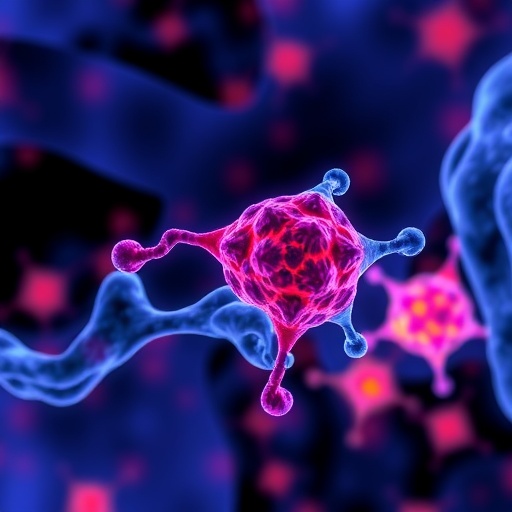
Acute myeloid leukemia (AML) represents one of the most formidable challenges in hematologic oncology, with its notorious resistance to conventional treatment regimens continuing to frustrate clinicians and researchers alike. Despite advances in chemotherapy and supportive care, many patients fail to achieve durable remission and ultimately relapse due to the intrinsic and acquired resistance mechanisms at the cellular level. At the heart of this resistance lies a complex dysregulation of apoptosis, the programmed cell death pathway critical to maintaining healthy cellular homeostasis. Recent breakthroughs, however, have illuminated a promising therapeutic avenue focused on BH3 mimetics—small-molecule agents that restore the apoptotic balance by targeting key pro-survival proteins within the BCL-2 family. These compounds herald a new era in AML treatment, especially for patients unable to endure the toxicity of intensive chemotherapeutic protocols.
The molecular underpinnings of AML resistance largely revolve around the overexpression of anti-apoptotic BCL-2 family proteins, which inhibit apoptosis by sequestering pro-apoptotic effectors such as BAX and BAK. Under physiological conditions, this balance ensures that damaged or potentially malignant cells are efficiently eliminated. However, AML cells exploit this safeguard by upregulating BCL-2 and related proteins, effectively blocking apoptosis and enabling unchecked proliferation. This dynamic disables intrinsic cell death pathways and confers a survival advantage in the hostile bone marrow microenvironment. Consequently, targeting these anti-apoptotic proteins has emerged as a logical and incisive strategy to tip the scales back in favor of cell death and tumor suppression.
Enter BH3 mimetics, a class of targeted therapeutics designed to mimic the activity of endogenous BH3-only proteins—key initiators of apoptosis that antagonize BCL-2 proteins. By binding with high affinity to the hydrophobic groove of pro-survival BCL-2 members, BH3 mimetics displace pro-apoptotic molecules, unleashing their cell-killing potential. Venetoclax, a pioneering BCL-2-specific inhibitor, has been at the forefront of this movement, demonstrating remarkable efficacy in overcoming the apoptotic blockade characteristic of AML. Its approval by the US Food and Drug Administration (FDA) for elderly and unfit patients marks a pivotal shift in AML management, replacing or augmenting conventional therapies with more nuanced, mechanism-based interventions.
Crucially, venetoclax’s success is amplified when used in combination with established standard-of-care (SOC) therapies. Integration with hypomethylating agents such as azacitidine or decitabine has produced synergistic effects, enhancing leukemia cell eradication while minimizing toxicity. These combinations have been validated in multiple clinical trials, showcasing improved overall response rates, progression-free survival, and complete remission frequencies. The tolerability profile also favors the elderly or comorbid patient population classically excluded from more aggressive chemotherapy, thereby addressing a long-standing unmet need in AML treatment. This transformation from nonspecific cytotoxic drugs to precision-targeted combination regimens underscores the therapeutic potential encapsulated within apoptosis modulation.
Despite these advancements, the landscape of AML remains complex, demanding continued innovation and refinement of BH3 mimetic strategies. Resistance eventually emerges even against venetoclax-based therapies, often through upregulation of alternative anti-apoptotic proteins like MCL-1 or BCL-XL, or through mutation-driven signaling pathway alterations. To circumvent these escape routes, next-generation BH3 mimetics targeting a broader spectrum of pro-survival proteins are under intense investigation. Early-phase clinical trials involving MCL-1 inhibitors show promise in overcoming refractory disease, hinting at a future where combinatorial cocktails of BH3 mimetics could forestall AML relapse and achieve longer-lasting remissions.
Embedded within this evolving therapeutic milieu are sophisticated biomarker-driven approaches aimed at personalizing treatment. Molecular profiling of individual patients’ leukemia cells can reveal the dominant anti-apoptotic dependencies, guiding the selection of the most effective BH3 mimetic or combination regimen. This precision medicine paradigm not only enhances efficacy but also mitigates unnecessary exposure to potential adverse effects, optimizing patient quality of life. Incorporation of real-time biomarker monitoring further permits dynamic treatment adaptation, tracking emerging resistance to switch therapies before clinical relapse occurs.
Understanding the intricate apoptotic networks in AML has also revived interest in exploring the interaction between BH3 mimetics and the tumor microenvironment. Bone marrow stromal cells provide a sanctuary for leukemic blasts, secreting cytokines and growth factors that modulate apoptotic signaling and drug sensitivity. New experimental data suggest that BH3 mimetics can sensitize not only the malignant cells but also disrupt these protective niches, enhancing drug penetration and cytotoxicity. The multi-faceted mechanism of action thus extends beyond direct apoptosis induction, implicating a broader anti-leukemic effect that disrupts leukemia-supportive ecosystems.
In addition to their therapeutic promise, BH3 mimetics are redefining our conceptual framework of apoptotic regulation in cancer biology. By selectively neutralizing anti-apoptotic proteins, they reveal the otherwise latent apoptotic vulnerabilities within AML cells. Insights gleaned from these studies extend beyond leukemia, opening novel research pathways applicable to other malignancies sharing similar apoptotic dysregulation. The potential to harness mitochondrial priming and intrinsic death pathways represents a new frontier in cancer treatment research, one that may finally unravel the complexities of tumor resistance.
Challenges remain, particularly in managing adverse effects such as tumor lysis syndrome and myelosuppression associated with BH3 mimetics. Rigorous patient monitoring and stepwise dose escalation protocols have been implemented to mitigate these risks, emphasizing the need for meticulous clinical management during therapy initiation. Moreover, the interplay between BH3 mimetics and immune modulation is an area of growing interest, with recent evidence suggesting that apoptotic cell death may enhance anti-tumor immune responses, potentially synergizing with emerging immunotherapies.
The journey toward fully realizing the therapeutic potential of BH3 mimetics is accelerated by rapidly expanding translational research and clinical trials globally. Novel agents with improved selectivity, reduced toxicity, and greater potency are entering the clinical pipeline. Combinations integrating BH3 mimetics with targeted kinase inhibitors, epigenetic modulators, and immune checkpoint blockers are being explored to leverage multi-modal eradication of AML. Such integrative strategies could transform the prognosis for AML patients, particularly those historically classified as high-risk or unfit for intensive regimens.
The story of venetoclax and its successors stands as a testament to the power of targeted apoptosis modulation in overcoming cancer’s formidable defenses. This transformative paradigm not only enhances survival outcomes but also ushers in a new era of rational drug design tailored to the molecular biology of disease. As clinical experience grows, ongoing efforts will focus on optimizing dosing, sequencing, and combination partners to maximize durable responses. Collectively, these advances embody a hopeful vision where AML’s grim statistics are replaced by steadily improving cure rates and quality of life for patients across the globe.
In conclusion, BH3 mimetics have uncovered an Achilles’ heel in acute myeloid leukemia by directly intervening in the apoptotic machinery hijacked by cancer cells. These agents exemplify the convergence of molecular biology, medicinal chemistry, and clinical oncology into effective, life-extending therapies. While challenges remain, the promise of BH3 mimetics to transform AML treatment from an intractable malignancy into a manageable disease represents one of the most exciting developments in contemporary cancer therapy. Continued investment in research and clinical innovation will be paramount in ensuring that these advances translate into widespread clinical benefit.
As the field progresses, the focus will increasingly shift to individualized therapeutic schemas, capturing the heterogeneity of AML and its evolving resistance patterns. Multi-parameter diagnostic platforms encompassing genomics, proteomics, and functional assays will guide precision application of BH3 mimetics alongside an expanding arsenal of anti-leukemic agents. This integrative, biology-driven approach heralds a future in which the lethality of AML is mitigated by sophisticated, personalized interventions that restore the fundamental process of programmed cell death integral to human health.
Ultimately, the emergence of apoptosis-targeting BH3 mimetics signifies more than a new class of drugs—it marks a paradigm shift in how we conceptualize and address resistance in acute myeloid leukemia. This breakthrough offers renewed hope for patients, clinicians, and researchers committed to conquering one of the most aggressive hematological cancers, reshaping the landscape of AML therapy for years to come.
Subject of Research: Therapeutic targeting of apoptosis pathways in acute myeloid leukemia using BH3 mimetics.
Article Title: Apoptosis-targeting BH3 mimetics: transforming treatment for patients with acute myeloid leukaemia.
Article References:
Glaviano, A., Weisberg, E., Lam, H.Y. et al. Apoptosis-targeting BH3 mimetics: transforming treatment for patients with acute myeloid leukaemia. Nat Rev Clin Oncol (2025). https://doi.org/10.1038/s41571-025-01068-0
Image Credits: AI Generated
Tags: acute myeloid leukemia treatment advancementsapoptosis dysregulation in AMLBCL-2 family proteins in leukemiaBH3 mimetics in cancer therapyinnovative treatments for leukemia patients.intrinsic apoptosis pathways in AMLnovel therapeutic strategies in hematologic oncologyovercoming chemotherapy resistance in AMLpro-survival proteins in cancerresistance mechanisms in acute myeloid leukemiasmall-molecule agents for leukemiatargeted therapy for acute myeloid leukemia




